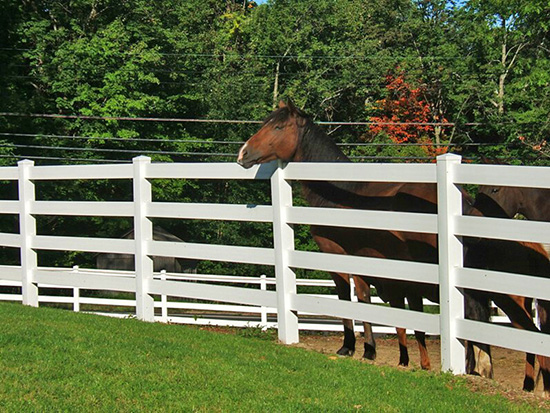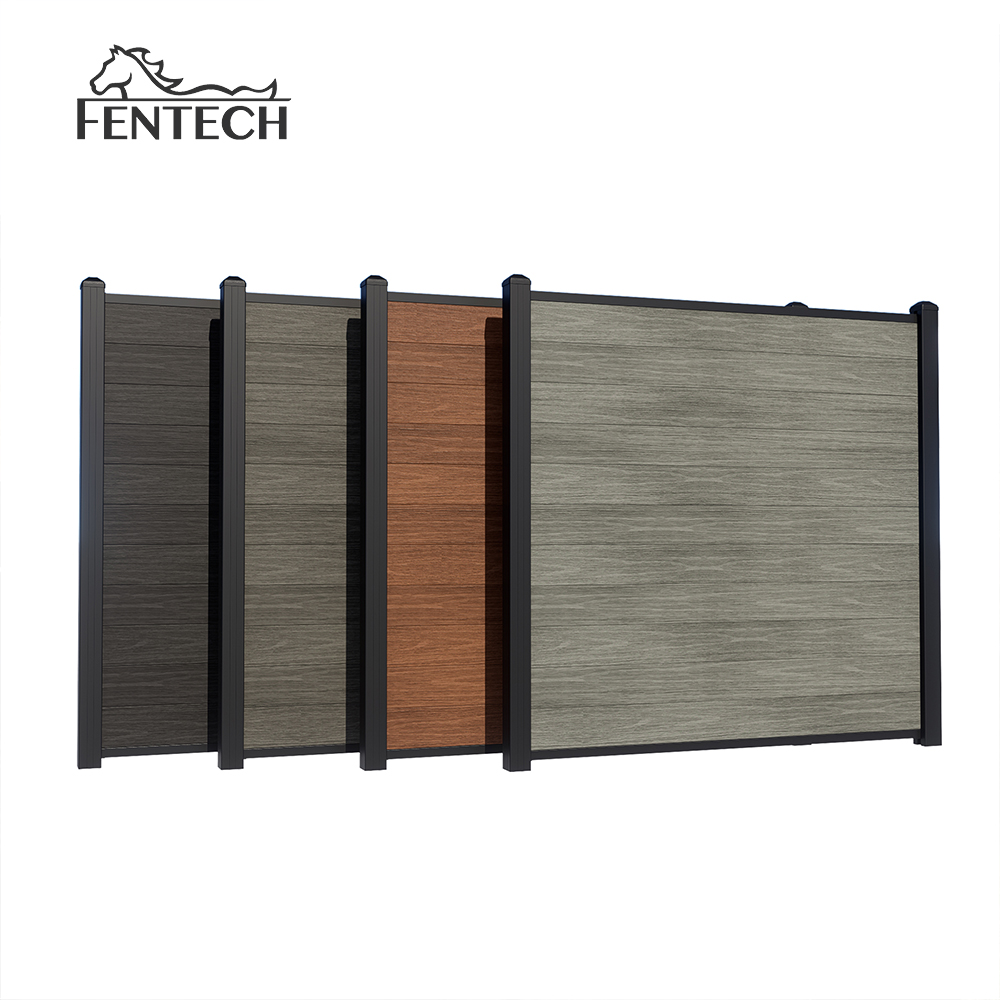We are professional China Custom Vinyl Fence Manufacturers with fences virgin PVC/Vinyl material and UV Protected.
Equestrian fencing has always served a dual purpose. On one hand, it is a critical safety feature that protects horses, riders, and property. On the other, it defines the visual identity of a stable or estate. A well-designed fence should therefore balance functionality and beauty. It must be strong enough to withstand the wear of hooves and weather, while also harmonizing with the landscape and architecture around it. Achieving this balance requires thoughtful consideration of design, materials, placement, and ongoing maintenance.
Understanding the Dual Role of Equestrian Fencing
Before considering materials or colors, it is essential to understand that a fence in an equestrian setting is more than a boundary. It is part of a system of safety, communication, and visual appeal. Horses are powerful, curious, and social animals. They interact with their environment constantly, and fencing must be built to withstand their behavior. At the same time, a fence forms part of the first impression of any equestrian facility. The shape, symmetry, and overall presence of the structure can enhance the sense of professionalism and care that the facility conveys.
Combining these roles means thinking in terms of both form and function. A practical design must prioritize safety and durability, but it should also respect the natural beauty of the setting. The goal is to achieve a look that feels intentional and inviting, without compromising performance or ease of use.
Considering Safety and Function First
Aesthetic goals should always follow safety and function. The most beautiful fence is meaningless if it poses a risk to a horse. Therefore, any design process should begin by identifying how the fencing will be used. Will it enclose a training arena, a pasture, or a paddock? Each purpose carries its own structural requirements.
For example, paddock fencing needs to be tall enough to prevent jumping, strong enough to resist leaning or rubbing, and visible enough to avoid accidental collisions. Arena fencing, by contrast, may need a smoother surface to prevent injury if a horse brushes against it. The first step toward functional beauty is choosing a design that fits the use case precisely.
Durability is another pillar of functionality. Horses often test boundaries. They nibble, kick, and push against fences. A functional fence must therefore combine resilience with low maintenance. Materials that resist moisture, insects, and impact not only keep horses safe but also maintain an attractive appearance over time.
Choosing Materials that Balance Form and Function
The choice of material is the foundation of any equestrian fencing design. Different materials offer distinct advantages in terms of strength, safety, and visual style.
Wood fencing remains a timeless choice. It is warm, natural, and versatile, blending seamlessly with rural and suburban landscapes alike. When properly treated, wood provides adequate strength and a pleasant, organic look. However, it requires regular maintenance such as painting, staining, or sealing to prevent rot and insect damage. For those seeking a traditional aesthetic, wood is unmatched, but it does demand consistent care.
Vinyl fencing offers a clean and modern look while reducing maintenance requirements. It does not warp, crack, or fade easily. The smooth surface also minimizes the risk of injury. Vinyl can imitate the appearance of wood while offering greater longevity, though it can be more expensive initially. For larger properties, vinyl may offer the best balance between appearance and practicality.
Metal fencing, often made of steel or aluminum, provides exceptional durability and a sleek, contemporary appearance. Tubular steel rail fences, for example, can create a refined visual statement while maintaining strength. However, metal must be treated to resist corrosion, especially in humid or coastal regions.
Electric fencing, while not usually the most visually appealing option on its own, can be integrated into a larger design. When combined with post-and-rail structures, it becomes nearly invisible yet highly functional. Electric strands can reinforce traditional fencing without compromising appearance.
The key to balancing aesthetics and functionality is not necessarily choosing one material but understanding how different materials complement each other. Hybrid fencing solutions often achieve the best results. For instance, combining wooden posts with electric tape or wire can preserve a natural look while enhancing containment and safety.
Designing for Visibility and Harmony
Visibility is a crucial consideration for both aesthetics and safety. Horses have limited depth perception, so they need to clearly see boundaries to avoid injury. Fencing that blends too closely into the background may look elegant from a distance but can become hazardous in practice.
Choosing colors that contrast gently with the environment ensures both beauty and clarity. For example, a white or light gray fence stands out against green grass, while darker tones may suit sandy arenas or wooded areas. The goal is not to make the fence conspicuous, but to create a subtle distinction that helps horses recognize their limits and gives the property a defined frame.
Harmony with the landscape is another principle of good design. A fence should complement its surroundings rather than dominate them. Smooth, consistent lines lend a sense of order and refinement, while curves can soften the geometry of a large field. Aligning the fence with natural contours such as tree lines or gentle slopes makes it feel like part of the environment rather than an imposition on it.
When the fencing design reflects the terrain and architectural features of nearby structures, the overall result feels cohesive and intentional. Even a simple post-and-rail fence can look elegant if its layout respects the rhythm of the land.
Considering Proportions and Layout
The visual proportions of a fence influence both function and perception. Too low, and it may look incomplete or fail to contain horses; too high, and it can feel restrictive or harsh. Standard fence heights for horses range between 1.2 and 1.5 meters, depending on the breed and activity. Within this range, balance is key. Uniform post spacing creates rhythm, while well-defined corners and gate placements add structure.
Layout planning should account for both human and horse movement. Gates should be placed for convenient access without disrupting the visual flow. Entry points that align with paths or roads appear natural and organized. Long, straight runs give a formal, traditional look, while gently curved fencing lines evoke openness and calm.
If space allows, combining different fence styles within one property can enhance visual interest. For instance, using post-and-rail fencing around the main arena and wire-mesh fencing for outer pastures can create distinct functional zones while maintaining aesthetic unity.

Integrating Technology and Modern Design
Modern fencing solutions increasingly incorporate technology without sacrificing appearance. Flexible rail systems made from synthetic materials, for instance, offer the look of traditional wood but with added safety. These systems bend under pressure and return to shape, reducing the risk of injury. Their clean lines and smooth surfaces suit both classical and contemporary designs.
Solar-powered electric systems are another example of blending innovation with practicality. The panels can be discreetly mounted near gateposts, allowing for sustainable power generation without disrupting the visual harmony of the site.
Invisible fencing or low-visibility electrified tape can be used where the landscape view is a priority. While these options should never replace physical barriers in high-traffic areas, they can supplement fencing in larger or less critical zones, helping maintain open sightlines while still ensuring containment.
Maintenance as a Design Element
Aesthetic longevity depends heavily on maintenance. Even the most beautiful design will deteriorate if neglected. Choosing materials that age gracefully reduces long-term upkeep and preserves beauty. Regular inspection and care are part of the functionality equation.
For wooden fences, maintenance may include repainting or sealing every few years. Vinyl fences require occasional cleaning with water and mild detergent to maintain their appearance. Metal fences benefit from rust-resistant coatings and periodic checks for corrosion or loose fittings.
Design choices that simplify maintenance contribute to both form and function. For example, selecting post caps that prevent water infiltration extends the life of posts while giving them a finished look. Choosing uniform fasteners and modular components can make repairs seamless, preserving aesthetic consistency across the property.
Environmental and Sustainable Considerations
A growing number of equestrian property owners are considering sustainability as part of both the functional and aesthetic equation. Environmentally conscious materials such as recycled composites, bamboo, or reclaimed wood can provide a unique appearance while reducing environmental impact.
Sustainability also extends to the installation process. Aligning fencing to minimize soil disruption and preserve natural drainage maintains the health of pastures and prevents erosion. Planting low-maintenance ground cover or native shrubs along fence lines can soften visual edges while promoting biodiversity.
By designing with sustainability in mind, fencing becomes not only a protective structure but a statement of stewardship and respect for the environment.
Creating a Unified Visual Identity
In large equestrian facilities, the fencing design contributes to the property’s overall visual identity. Consistency in style, color, and spacing across different areas creates a sense of cohesion. While each paddock or arena may serve a different function, the repeated visual language of the fencing ties them together.
This does not mean uniformity is the only path to beauty. Subtle variations can highlight different zones. For example, decorative entry fencing can add a sense of arrival, while more functional boundaries remain understated. The key is to ensure that all variations still belong to the same aesthetic family, sharing similar materials or proportions.
Lighting also plays a role in aesthetics and safety. Soft, well-placed illumination along entryways and major fence lines enhances visibility at night and accentuates architectural features without overwhelming the landscape.
Balancing Practicality and Personal Taste
Every property has unique needs and visual preferences. A small private stable may favor rustic charm, while a competition facility may require sleek professionalism. Functionality must always remain the foundation, but within that framework, there is room for creativity. Subtle design decisions—such as post shape, rail spacing, or color tone—can reflect personality and taste without compromising safety.
Practical considerations should guide these choices. A design that looks good but is expensive or difficult to maintain will not stay attractive for long. Likewise, a purely utilitarian fence may perform well but diminish the atmosphere of the property. The most successful equestrian fencing finds the balance point where purpose and beauty coexist.
Conclusion
Combining aesthetics with functionality in equestrian fencing requires thoughtful balance rather than compromise. Safety, durability, and ease of maintenance form the core of functionality. Harmony, proportion, and visual unity define the aesthetic side. When both are given equal weight, fencing transcends its role as a mere boundary and becomes a defining feature of the landscape.
By selecting suitable materials, respecting the natural terrain, and maintaining consistent design principles, it is possible to create fencing that protects horses, enhances property value, and expresses a sense of elegance. The result is an environment that is both secure and visually inspiring—one where form and function truly ride side by side.
 English
English  中文简体
中文简体
























